
Executive Summary: Stablecoins provide the benefits of blockchain technology, while avoiding the volatility associated with cryptocurrencies. Some benefits of stablecoins are near-instantaneous settlement, privacy, transparency, and reduced transaction costs.
These benefits make stablecoins useful for many purposes: on-ramps and off-ramps to fiat, ease of payments, remittances, market liquidity, and stable savings. Stablecoins also facilitate speedy peer-to-peer transactions, while reducing costs associated with currency exchange rates and banking fees. Stablecoin volumes continue to expand, indicating stablecoins are a useful technology with many novel uses.
There’s traditional money, and there’s digital money. Think of stablecoins as the best of both worlds.
Stablecoins aim for the stability of traditional (or fiat) money, with the benefits of blockchain technology. They have all the bells and whistles of cryptocurrencies (transparency, programmability, and cost efficiency), but also provide investors with a safe haven from the volatility of the crypto markets.
Here are a few of their benefits.
Instant Settlement
Traditional fiat is often bloated with third-party services. These services add costs without adding much value. Plus, third-party services often lengthen transaction processing times.
By contrast, stablecoins allow for transactions to be settled nearly instantaneously. Their decentralized blockchain networks and smart contract technology operate 24/7 and don’t require third parties to verify transactions.
Eliminating third-party services greatly reduces transaction costs. In fact, the average stablecoin transaction cost is 98% cheaper than the average cross-border payment cost (0.1% vs. 6.4%, respectively, as of the first quarter of 2021).
Better Privacy
Traditional fiat money can breach consumer privacy through physical surveillance, identity checks, and even data breaches in financial institutions.
Stablecoins offer better privacy and personal security. Users can remain anonymous through:
- pseudonyms,
- stealth addresses,
- ring signatures, and
- different types of zero-knowledge proofs.
These features retain the stablecoin holder’s privacy and reduce the risk of identity theft and fraud.
Better Transparency
Traditional fiat lacks transparency, which can lead to issues like inflation and economic instability. For example, without built-in trust mechanisms allowing us to verify the money supply, who’s to say how much money governments are printing?
Stablecoin transactions, on the other hand, can be audited in real time. Anyone can access transfer-related data using a public key, so issues and disputes are easily resolved.
Note that the identity of the individuals conducting the transactions remains anonymous to retain privacy. Blockchain technology can obscure specific transaction details while allowing validators to verify legitimate information.
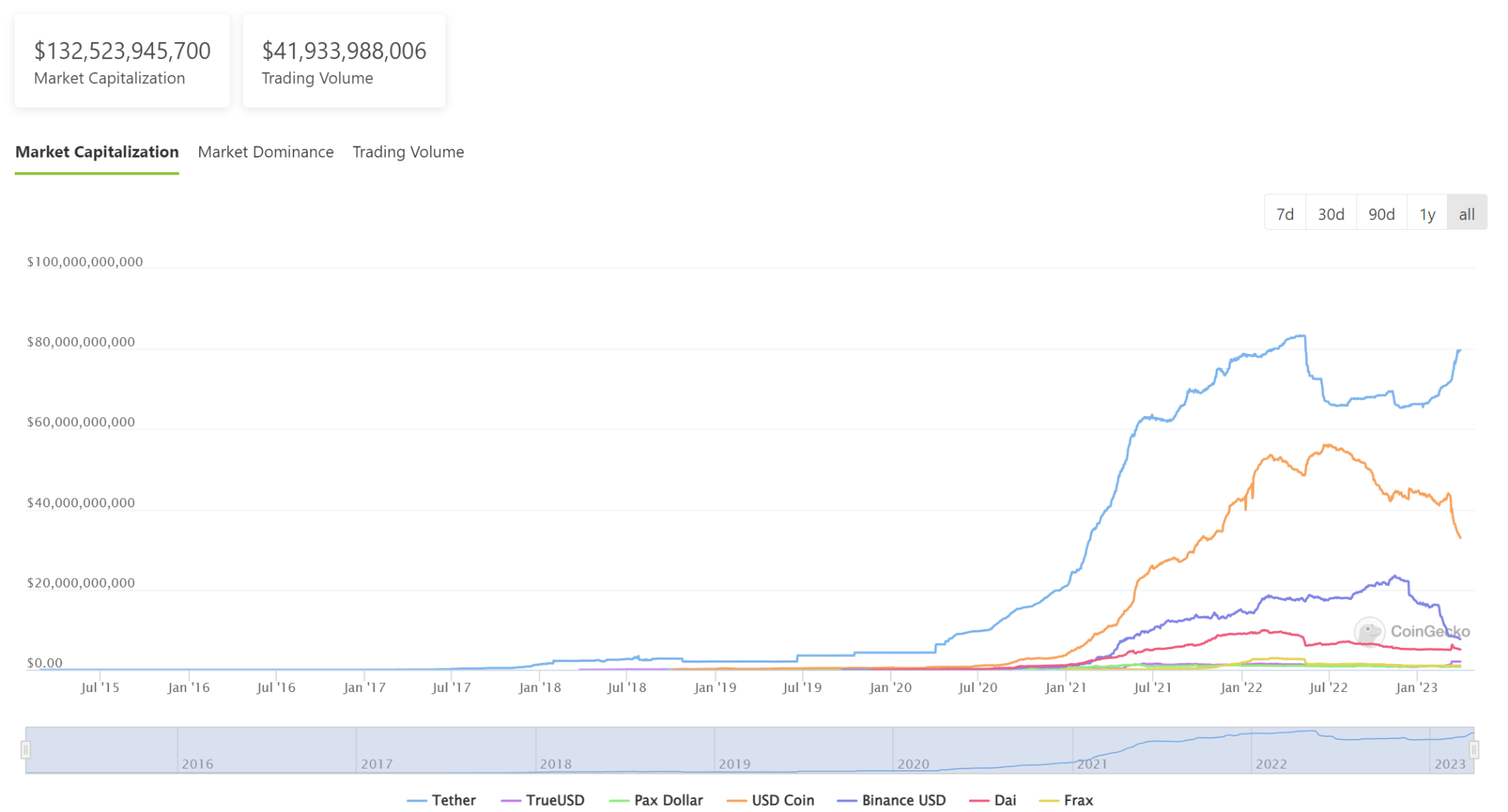
Also, many stablecoins regularly publish audit reports that detail their holdings and the assets backing their stablecoin. The regular reports ensure holders their digital currencies are fully-backed by tangible assets.
Top Stablecoin Use Cases
As stablecoins grow in popularity, we’ll explore the most common use cases, and see how this new technology is revolutionizing how we handle our money.
1. On-ramps/Off-ramps
On-ramps are the platforms you use to purchase and enter the crypto ecosystem, while off-ramps refer to converting digital currencies back to fiat.
Stablecoins bridge traditional finance (TradFi) and decentralized finance (DeFi), and help ease the transition into this new monetary system. While you can use your fiat currency to buy any digital asset, stablecoins are widely supported because DeFi platforms and protocols are confident in their stability.
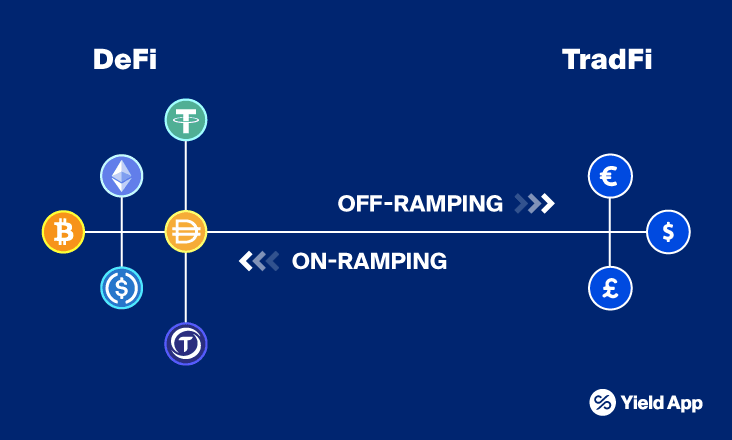
2. Payments
Stablecoins can be used to facilitate speedy peer-to-peer transactions and payments. Even microtransactions can be automated through smart contracts, reducing the need for manual intervention.
Additionally, stablecoins are highly liquid and can easily be swapped with fiat through various exchange platforms. Alternatively, some consumers use a crypto debit card to purchase real-world goods with stablecoins.
3. Remittances
Stablecoins can also be used for remittances and cross-border payments. This eliminates the need for third-party institutions, and reduces costs associated with exchange rates and transfer fees. Verification processes are done on-chain, reducing transaction times from days to minutes.
Compared with other digital currencies, stablecoins also reduce the risk of price volatility in remittances.
4. Market Liquidity
Providing liquidity for crypto traders is another popular use case for stablecoins. Stablecoins can be used as one of two currencies that form a trading pair on exchanges. They enable traders to quickly move in and out of positions without opening their portfolios to unwanted risks. As they wait for the next great opportunity, stablecoins provide a mechanism for traders to maintain the value of their assets without needing to off-ramp into fiat.
Stablecoins can also be traded globally, giving participants access to new global markets. As of March 31, 2023, the total trading volume for stablecoins has globally totaled over $22bn USD. That is a large increase from the $364 million USD in trading volume of stablecoins toward the end of 2018.
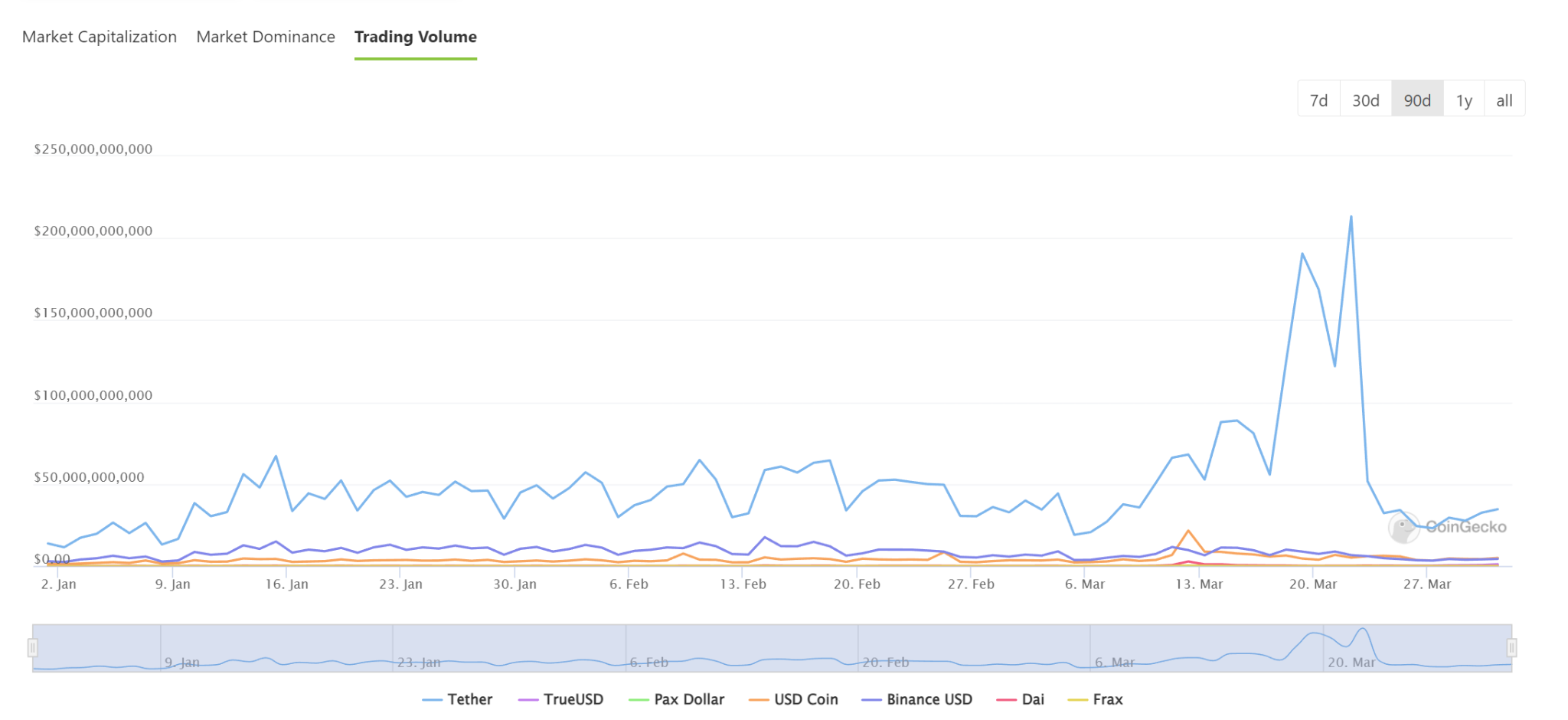
5. Savings
An underrated but common use case of stablecoins is to hold money as savings. Stablecoins were created to have stable value. Since they have no vesting or lock-in period, users can easily transfer money in and out of wallets, saving and spending when they need it.
For non-traders, stablecoins can also be an alternative to a high-yield savings account. According to the FDIC, savings accounts’ average interest rate is about 1.28%. Stablecoins can offer as high as 8% APY to offset the inherent risks of stablecoins de-pegging and losing value without insurance or government protection.
6. Lending and Staking
As of February 2023, over $24.5 billion of stablecoins were locked in in the top stablecoins USDC, USDT, and DAI.
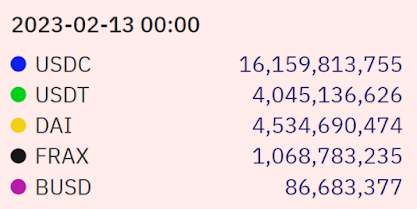
Lending and staking provide liquidity to exchanges, institutions, and sometimes even individuals. Unlike Ethereum, stablecoins like USDT and USDC do not use the Proof-of-Stake consensus mechanism, so staking on these platforms is more like a money market deposit than anything else.
While these mechanisms yield a larger APY than a savings account, the difference and drawback lie in the lockup or “vesting” period, where you can’t touch or transfer your crypto for a specified time. In effect, you trade off liquidity for the benefit of higher rewards.
Proving that more money is lent and staked in DeFi because of stablecoins is a simple matter of looking at the total value locked (TVL) in stablecoin protocols. TVL, after all, refers to the total value of assets vested for lending and borrowing. As of this writing, the top three assets by TVL are all stablecoins: USDT, USDC, and DAI.
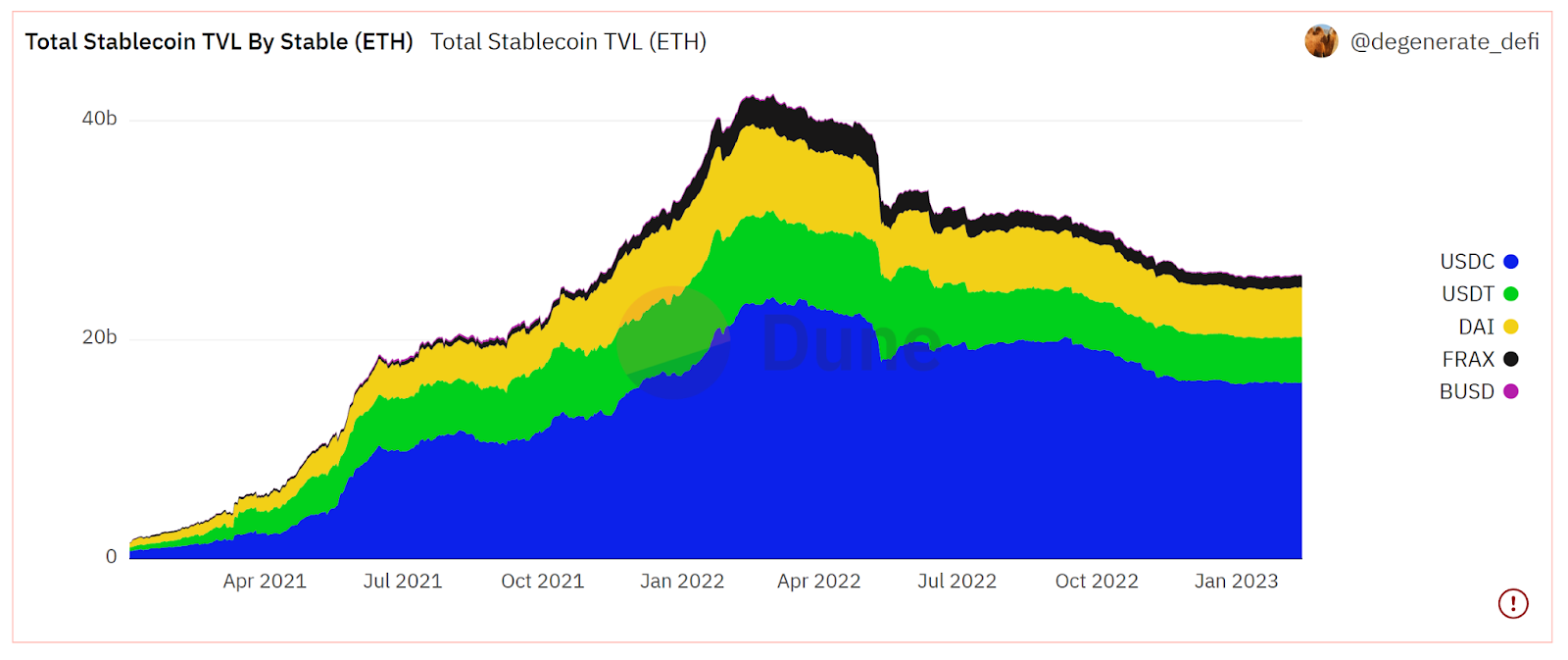
7. Gaming
Gaming dapps account for nearly 30% of decentralized applications on the market. In effect, gaming is another industry ripe for stablecoin adoption.
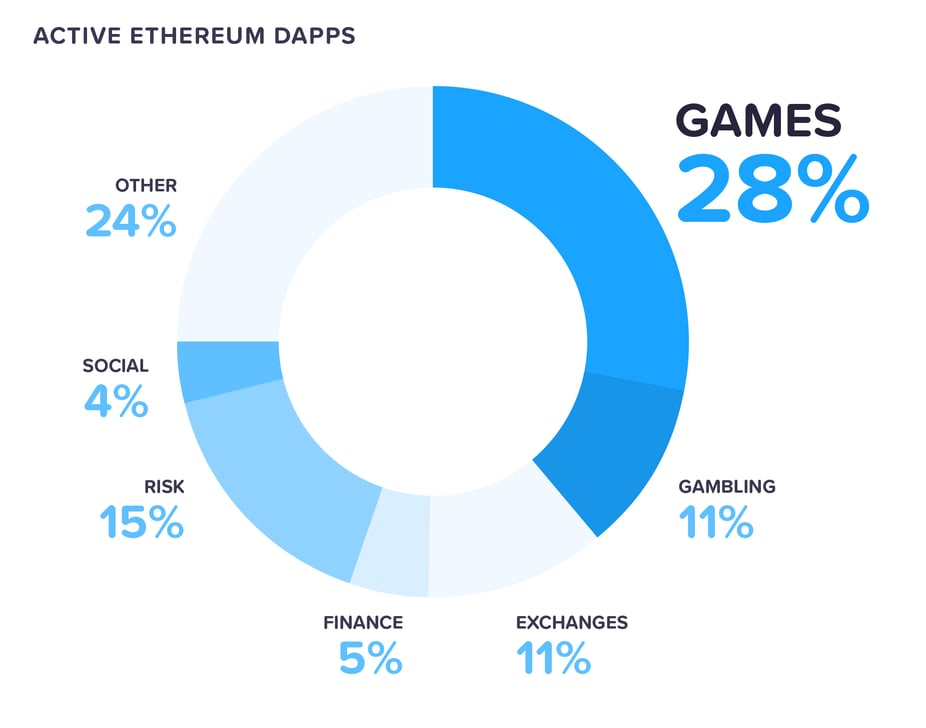
Either as in-game currencies or for gambling purposes, stablecoins can bring in-game assets out of the game’s infrastructure and into digital dollars. Stablecoins are used by gaming projects as a means to:
- Monetize in-game currency.
- Create new payment infrastructures.
- Charge commissions on in-game activity.
In doing so, players should be allowed to buy, sell, and trade their earned digital assets on-chain and off-chain. While gaming coins in the past have emerged as a solution to revamp the gaming industry’s economy, none have succeeded in light of high price volatility and lack of interoperability: issues that stablecoins have already resolved.
The Future of Stablecoins
Stablecoins are viable in these use cases because their inherent benefits (low transaction costs, instantaneous payment, anonymity, and programmability) support the use cases that currently drive the adoption of this technology.
Looking forward, we will likely see stablecoins redefining how we hold cash and use our money. Crypto investors can expect growth in areas such as:
- Payment systems;
- Tokenized markets; and
- Microtransaction facilitators.
While many of these use cases may see mass adoption within the next decade, central bank digital currencies, or CBDCs, are also being put forward as an alternative to stablecoins. CBDCs present themselves as stablecoin alternatives that resolve many of stablecoin’s issues, such as liquidity, operational risks, security, and regulatory challenges.
CBDCs will give banks control over the digital currencies issued by central bankers. Finextra’s report suggests that 20% of central banks are interested in issuing a CBDC within the next decade. This push for digital currency, while good for the overall crypto market, calls into question the feasibility of DAO-operated stablecoins over the long run.
The ready acceptance of CBDCs means that traditional banks will own a majority share of the stablecoin market once regulations are established. Compliance and legal functions are weak links for newer players like Tether and Circle. However, established banks have an infrastructure and loyal customer base to support the push toward a cashless society.
They need the technology now, and CBDCs remain the likely solution.
Investor Takeaway
Stablecoins provide transparent, private, and low-cost transactions at high speeds, which is why cryptocurrency’s success is contingent on this technology’s mass adoption. The technology provides a crucial link between TradFi and DeFi by providing stability and reliability.
On the other hand, regulatory and operational risks and the threat of depegging will continue to plague stablecoin technology, which is why alternatives like CBDCs remain attractive to governments.
Our investing philosophy has between 2 and 10% of your investment portfolio in crypto assets. Although we follow a long-term, buy and hold approach, if you do decide to sell crypto investments, you can keep the cash in high-quality stablecoins, where you can earn staking rewards, and remain ready to pounce on the next great investment opportunity.
Need more up-to-date insights covering the latest market trends? Subscribe to Bitcoin Market Journal.

